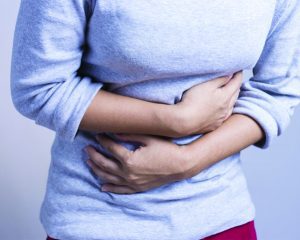By Adam P. Lipkin, MD, Fellow American College of Surgeons


The main point about belly pain that I would like to get across is that pain in the abdomen is NOT the same as pain from a sore back or aching muscles. When internal organs are causing pain, it is far more serious than other causes of discomfort. The conditions that we will discuss do not get better with time, ice, or an anti-inflammatory. So take belly pain seriously, and seek prompt medical attention, especially if the pain is severe or is associated with nausea, vomiting, change in bowel habits, bloating of the abdomen, or fever. If you are doubled over in pain, it is best to get to the emergency department right away. As a surgeon, I commonly see people who have stubbornly delayed medical attention and ended up with gangrene and severe peritonitis (life threatening infection of the abdominal cavity).
We will start with some of the common conditions causing upper abdominal pain: ulcers, gallbladder disease, and pancreatitis.
An ulcer is an erosion to the lining of the stomach or first part of the intestine. Typically there is a dull, gnawing pain in the upper mid abdomen accompanied by a feeling of fullness or nausea. Sometimes the pain gets better after eating and is worse on an empty stomach. Ulcers are typically diagnosed by an upper endoscopy (a procedure done under sedation) and treated with medicines to reduce stomach acid production. It is also important to correct the factors that may have contributed to the ulcer, such as smoking, alcohol use, NSAID use (e.g. aspirin, ibuprofen) and a bacterial infection called H. Pylori. Sometimes ulcers can bleed causing vomiting or black, tarry bowel movements. Even worse, an ulcer can perforate, meaning erode through the stomach and cause leakage into the abdominal cavity. Both of these conditions demand hospitalization.
Gallbladder disease (see swfhealthandwellness.com March, 2018 edition) typically causes pain in the upper right abdomen after meals and is associated with nausea, bloating, and gassiness (both ends). An ultrasound is the first step to diagnosis. Mild attacks last a few hours and can be treated with outpatient minimally invasive surgery to remove the gallbladder. Left untreated, attacks typically become more severe and often require hospitalization.
Pancreatitis (inflammation of the pancreas) is most often due to gallbladder disease or alcohol
abuse. Typically there is severe, constant, upper left abdominal pain going into the back. Someone with pancreatitis typically is unable to eat and is severely ill. This is an emergency requiring hospitalization.
Now we will move on to the lower abdomen to discuss diverticulitis, appendicitis, and other causes of pain.
A common cause of pain in the left lower abdomen, especially in people over 50, is diverticulitis. Everyone has heard of it but most people do not understand what it is. The first thing to know is that diverticulosis is a condition that about half of older Americans have where small outpouchings (diverticula) have formed in the wall of the colon over the years.
Diverticulitis occurs when a diverticulum ruptures and leads to infection. Typically, it is preceded by constipation and altered bowel movements.
There is pain and tenderness to the touch in the lower left abdomen. There is loss of appetite. Most cases are treated with antibiotics at home but severe cases can require hospitalization and even emergency surgery. The best way to avoid both diverticulosis, and diverticulitis, is by avoiding pressure in the colon. This means having a high fiber diet, avoiding constipation, staying active, and maintaining a healthy weight. People experiencing recurrent diverticulitis should consider having the diseased part of their colon (the last foot or so called the sigmoid colon) removed.
People with appendicitis typically experience rapidly worsening belly pain that may start as a vague belly ache but soon becomes intense and distinctly located in the lower right abdomen. Within less than a day the pain is usually so bad that it is difficult to move around. There is loss of appetite and sometimes fever. Emergency evaluation is recommended anytime appendicitis is suspected because prompt surgery is necessary.
A common cause of pain in the groin is a hernia, usually identified by a lump or protrusion. Please see swfhealthandwellness.com, February 2018 edition for a full explanation of inguinal hernias but know that if a hernia is uncomfortable then it should be repaired. Numerous other conditions can cause lower abdominal pain and may come from the urinary or reproductive tract. Again, this article cannot cover it all. So if you have concerns about abdominal pain, call my office or meet with your doctor.
Dr. Adam P. Lipkin has been practicing General Surgery in Southwest Florida since 2001. Dr. Lipkin specializes in minimally invasive surgery and has the advantage of modern, up to date training coupled with 2 decades of Operating Room and Endoscopy experience. Dr. Lipkin is Board Certified in General Surgery, and is a member of the American College of Surgeons.
941.475.5431
www.dradamplipkin.com
779 Medical Dr., Suite 1
Englewood, FL 34223
 Southwest Florida's Health and Wellness Magazine Health and Wellness Articles
Southwest Florida's Health and Wellness Magazine Health and Wellness Articles

